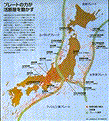2.3 Regional Seismicity and Tectonics
The earthquake occurred in a region where a complex system of active faults had been previously mapped (Research Group for Active Faults in Japan, 1980; Figure 2.1). The focal mechanism of the earthquake indicates right-lateral strike-slip faulting on a nearly vertical fault striking slightly east of northeast, parallel to the strike of the mapped faults (Pitarka et al., 1995). The earthquake mechanism is compatible with the tectonic environment of western Japan as revealed by historical seismicity. This seismicity contains a sequence of earthquakes between 1891 and 1948 which includes the magnitude 8 Nobi earthquake of 1891, the magnitude 7.3 Tango earthquake of 1927, the magnitude 7.2 Tottori earthquake of 1943, and the magnitude 7.1 Fukui earthquake of 1948 (Kanamori, 1973). All of these earthquakes, as well as the 1995 earthquake, had strike-slip mechanisms that accommodated east-west shortening of the Eurasian plate due to its collision with the North American plate along the Izu-Itoigawa line to the east in central Honshu (Huzita, 1980), as illustrated in Figure 2.3. The last major earthquake (M>7) in the near vicinity of Kobe occurred in 868; it is believed to have been generated on the Yamasaki fault, which is located about 50 km northwest of the epicenter of the Kobe earthquake (Kanamori, 1995). Kobe was probably also affected by a magnitude 7 earthquake in 1596 whose effects were most strongly felt in the region between Kyoto and Osaka. A smaller magnitude earthquake (M=6.1) occurred near the epicenter of the 1995 Kobe Earthquake in 1916. In summary, the 1995 Kobe earthquake occurred on a mapped system of active faults, and had a mechanism that is compatible with the tectonics of western Japan as inferred from similar earthquakes that occurred during the past century. Currently available evidence does not suggest any difference between the source characteristics of the Kobe earthquake and those of crustal earthquakes that occur in California.
 Figure 2.3: Collision of the North American plate with the Eurasian plate in central Japan. Plate boundary faults and active crustal faults in Japan. Epicenters of large earthquakes during the past century are shown. Source: Newsweek, February 1, 1995, Japan edition.
Figure 2.3: Collision of the North American plate with the Eurasian plate in central Japan. Plate boundary faults and active crustal faults in Japan. Epicenters of large earthquakes during the past century are shown. Source: Newsweek, February 1, 1995, Japan edition.
![]() Figure 2.3: Collision of the North American plate with the Eurasian plate in central Japan. Plate boundary faults and active crustal faults in Japan. Epicenters of large earthquakes during the past century are shown. Source: Newsweek, February 1, 1995, Japan edition.
Figure 2.3: Collision of the North American plate with the Eurasian plate in central Japan. Plate boundary faults and active crustal faults in Japan. Epicenters of large earthquakes during the past century are shown. Source: Newsweek, February 1, 1995, Japan edition.